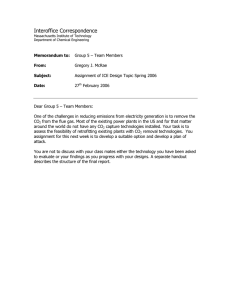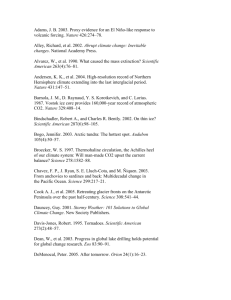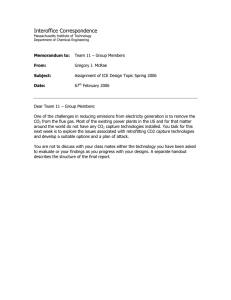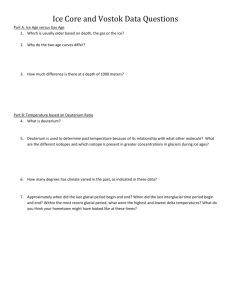Coca-Cola Fountain Beverage Quality Guide
advertisement
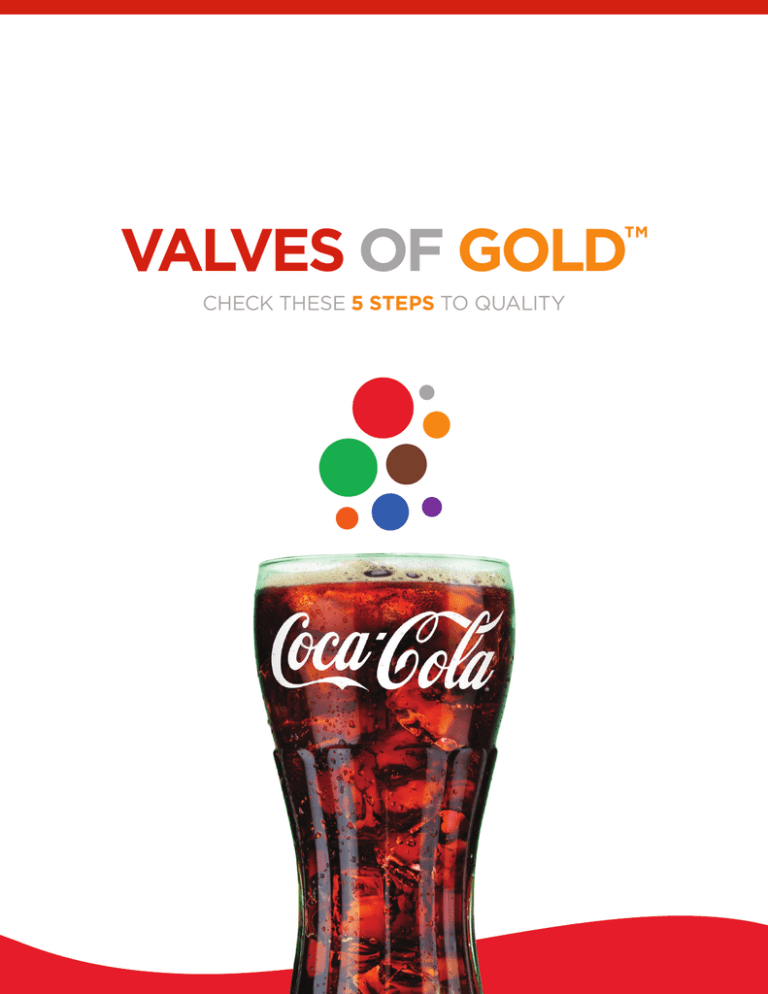
VALVES OF GOLD ™ CHECK THESE 5 STEPS TO QUALITY 5 STEPS TO SOFT DRINK QUALITY 1 ROTATION.......................................................................................................................3 It’s got to be fresh to taste just right. How to Change a BIB (Bag-in-Box)...........................................................................................................4 2REFRIGERATION...........................................................................................................5 If the drink isn’t cool, it melts too much ice and loses its fizz. Ice-Cooled Refrigeration.................................................................................................................................6 Mechanical Refrigeration................................................................................................................................7 Remote Refrigeration.......................................................................................................................................8 3CARBONATION..............................................................................................................9 A good soft drink has the sparkling fizz of proper carbonation. How to Change an Empty CO2 Cylinder................................................................................................. 11 Checking the CO2 Pressure Regulators.................................................................................................. 12 How to Check for a CO2 Leak..................................................................................................................... 13 4PRESENTATION........................................................................................................... 14 Who wants a soft drink from a dispenser that’s not clean? 5SENSATION................................................................................................................... 16 Be your own first customer! You know how good Coca-Cola© fountain beverages should taste. WATER ADVISORY............................................................................................... 18 Start-Up Procedures after Boil Water Advisory HELP!............................................................................................................................... 20 What’s That in Your Soft Drink Dispensing System?..............................................................................20 Ice-Cooled System Components...................................................................................................................... 21 Mechanical Refrigeration Systems.................................................................................................................. 22 Remote Refrigeration Systems......................................................................................................................... 23 Coca-Cola Customer Care Center................................................................................................................... 24 Spot Checks............................................................................................................................................................... 25 Troubleshooting Guide..........................................................................................................................................26 Quality Assurance Kit............................................................................................................................................ 32 COCA-COLA CUSTOMER CARE CENTER 1-800-241-COKE (2653) 2 STEP 1 ROTATION First In...First Out! FRESH! WHY IT’S IMPORTANT A Remember, great taste is why your customer orders a soft drink. Your customers expect to be served great-tasting fresh products. Fresh syrup is essential to producing great-tasting soft drinks. WHAT TO CHECK Syrups produced by The Coca-Cola Company for your soft drink system are packaged in Bag-in-Box containers. To make certain you always serve only fresh syrup, pay attention to these conditions… 1 Check the date code. Each syrup container is stamped with a date . code indicating the “Enjoy By” date. The date code is on a label affixed to the box. B 2 Rotate your syrup stock. Always use the oldest syrup first to maintain freshness. Remember FIFO...first in, first out (photo A)! (See page 4 for How to Change a BIB [Bag-in-Box]) 3 Avoid using syrup that is too old. Syrup should be used before “Enjoy By” date. 4 Soak the syrup line connector weekly or when changing BIBs. Soak connectors in chlorine-based sanitizer solution for 1 minute, and reconnect to the correct Bag-in-Box (photo B). SAFETY PRECAUTIONS • Never stack Bag-in-Box containers more than 5 high for 5 gallons. For 2.5 gallons, never stack containers more than 10 high. Be sure containers are stored at least 6 inches off the floor (photo C). • Never store near heat source, chemicals, pesticides, etc. • Never store outside or in cooler. C 3 HOW TO CHANGE A BIB (BAG-IN-BOX) 1 Unscrew the syrup line connector and remove the empty box (photo A). 2 Open the flap of the new box by hitting it sharply with your palm. DO NOT use a sharp instrument (photo B)! 3 Pull the bag connector through the opening and remove the plastic dust cap (photo C). 4 Soak connectors in chlorine-based sanitizer solution for 1 minute (photo D). 5 Reconnect to the correct Bag-in-Box. Tighten until the connectors are fully engaged (photo E). 6 Operate the dispensing valve to restore syrup flow (photo F). A B C D E F 4 STEP 2 REFRIGERATION How cool? 40° F or less! COOL! WHY IT’S IMPORTANT If the drink is warmer than 40° F when it is dispensed… • It tends to foam…losing its carbonation and producing a flat-tasting beverage. • It quickly melts ice…resulting in a weak, watery-tasting beverage. A To make sure your soft drinks are cool enough, check drink temperature daily. Just follow these simple steps… FIRST…SEE IF THE THERMOMETER IS RIGHT! 1 Test the thermometer accuracy. Place the thermometer in a full cup of ice with water added. Stir until the temperature reading remains constant. It should read exactly 32° F (photo A). Does it? 2 Adjust the thermometer. Locate the adjustment nut under the dial. With the thermometer inserted in the cup of ice water, turn the adjustment nut with an adjustable wrench until the dial needle points directly at 32° F (photo B). B THEN…CHECK DRINK TEMPERATURE! 3 Get cool product to the valve. If the valve has not been operated in the last thirty minutes, dispense a 20 ounce drink without ice and pour out (photo C). 4 Dispense a test drink. Draw a second drink without ice for testing drink temperature. Insert the thermometer and stir gently while not touching the sides of the cup (photo D). C 5 Read the temperature. After 15 seconds, the drink temperature should be less than or equal to 40° F (photo E). If not, the cause should be identified and corrected. (See page 6 for Ice-Cooled Refrigeration or page 7 for Mechanical Refrigeration or page 8 for Remote Refrigeration. In addition, refer to the Troubleshooting Guide in the Help section.) 5 A. ICE-COOLED REFRIGERATION HOW IT WORKS Many soft drink dispensing systems use ice to cool the beverage. Ice-cooled refrigeration relies on a cold plate, which is usually located on the bottom of the ice bin (photo F). WHAT TO CHECK If the drink temperature from your ice-cooled refrigeration system is above 40° F, check the following conditions… IS THE ICE BIN FULL ENOUGH? The cold plate works best when it’s COMPLETELY covered with ice. As a general rule, you should keep your ice bin 1/3 full at all times for proper cooling (photo G). IS THE ICE BIN DRAINING PROPERLY? The cold plate works poorly if the water from melting ice doesn’t drain away. IS THE ICE IN CONTACT WITH THE COLD PLATE? You should stir the ice periodically throughout the day to make sure ice is always in direct contact with the cold plate. Stirring breaks up gaps called “ice bridging” (photo H). D E F G H 6 B. MECHANICAL REFRIGERATION Some soft drink dispensing systems use a compressor to cool the beverage. This type of mechanical refrigeration unit may be located in the dispenser cabinet or in a remote location. HOW IT WORKS A water bath inside the refrigeration unit is cooled to form ice, which melts as it keeps the syrup and carbonated water chilled. The compressor starts whenever more ice is needed and shuts off when enough ice has been made. WHAT TO CHECK If the drink temperature from your mechanical refrigeration system is above 40° F, check the following conditions… IS THE REFRIGERATION UNIT NEAR A HEAT SOURCE? A mechanically cooled refrigeration system should NEVER be located near any major source of heat (ovens, grills, heaters, etc.). IS THE AIR FLOW TO THE COMPRESSOR BLOCKED? Cool air enters the front of the compressor, and warm air escapes from the top. If either air flow is blocked, the compressor will overheat and fail. Keep the front and top of the compressor clear at all times. IS THE REFRIGERATION UNIT PLUGGED IN? Check to be sure the unit is properly plugged in and that a circuit breaker has not been tripped. 7 C. REMOTE REFRIGERATION Some soft drink dispensing systems use a compressor system in the back room to cool carbonated water and syrup and a recirculating system to keep the carbonated water and syrup cool between the remote compressor system and dispenser valves in the dispensing area (photo A). HOW IT WORKS A water bath inside the remote refrigeration unit is cooled to form ice which melts as it keeps the syrup and carbonated water chilled. The compressor starts whenever more ice is needed and shuts off when enough ice has been made. A A separate motor and pump recirculate chilled carbonated water in the insulated lines between the compressor system remote unit and dispensers to keep the syrup cool (photo B). WHAT TO CHECK If the drink temperature from your dispensing valves is above 40° F, check the following conditions… B IS THE UNIT OR ARE INSULATED LINES NEAR A HEAT SOURCE? The refrigeration unit or insulated lines should never be near a major source of heat (ovens, grills, heaters, exhausts in the attic, etc.). IS THE INSULATED SYRUP AND WATER TUBING INTACT AND WELL-INSULATED AT ALL POINTS? Insulation is critical where the lines connect to the dispensing towers or the refrigeration unit. If the insulated tubing is not wrapped at these points or is exposed to air at other places, the line may become filled with condensed water from the air. This will cause the water and syrup in the lines to heat up. Only a service technician can correct the problem. IS THE AIR FLOW TO THE COMPRESSOR BLOCKED? Cool air enters from one side of the compressor and warm air escapes from another side. If either air flow is blocked, the compressor will overheat and fail. Keep both air flows clear at all times. Whether the compressor is located inside or outside the restaurant, it is necessary to ensure that the air flow remains unobstructed. IS THE COMPRESSOR SYSTEM PROPERLY CONNECTED TO THE ELECTRICAL POWER SOURCE? Ensure that the unit is plugged in and/or the circuit breaker has not been tripped. 8 STEP 3 CARBONATION BUBBLES! Bubbles! Fizz! Carbonate! A Proper carbonation comes from the right amount of carbon dioxide (CO2) gas being mixed with water in your soft drink system. HOW IT WORKS A CO2 cylinder contains liquid Carbon Dioxide under high pressure (photo A). As gas from the top of the cylinder flows out and mixes with water to make carbonated water, the amount of liquid in the cylinder is gradually reduced. B A Bulk Tank system is similar in use to a CO2 cylinder system but typically contains 200 to 400 lbs. of liquid Carbon Dioxide and is under less pressure (photo B). The bulk tank is typically filled by your CO2 supplier so tank changing is unnecessary. WHAT TO CHECK If your drink is flat or less carbonated than it should be, check to see… IS THE TANK FULL? You can tell a tank is empty by observing the 0 to 2000 PSI gauge (photo C). There are several types of gauges; some will have a red pie-shaped section indicating a tank change is required. Other tanks will have a red bar area. Some tanks will not have any markings; change these tanks when the pressure is under 500 PSI. If you have a bulk CO2 tank, you need to locate the contents gauge on top of the tank (photo D). Typically it looks like a gas gauge or an upside-down test tube. It should be above 1/4 full. Find the tank pressure gauge. If this gauge reads 120 PSI or less, the tank does not have enough pressure to push CO2 . If the content gauge is below 1/4 full or the tank pressure gauge is less than 120 PSI, then call your supplier for a refill or for tank service. C D 9 IS THE VALVE OPEN? This is easy to check on CO2 cylinders, and it’s amazing how often someone forgot to open the valve! A simple screw-type valve opens and closes the tank. • Turn the valve to the left to open the tank and to the right to close the tank (photo A). • Always open the valve completely when using the tank and close the valve when the tank is not in use. This stops CO2 from leaking around the valve stem. A IS THE PRESSURE SET CORRECTLY? If the pressure isn’t right, the carbonation won’t be right! Check the high pressure regulator and the low pressure regulator settings (photo B). Some of the latest regulator technology comes preset and does not require gauges (photo C). See Page 12 for instructions on checking these pressure regulators. B WARNING! CO2 IS HIGH PRESSURE STUFF Pay attention to these SAFETY PRECAUTIONS: • Keep CO2 cylinders standing upright! • They must be stored and used in the upright position at all times (photo D). Laying a CO2 cylinder down could cause damage to the valve, resulting in a dangerous, out-of-control gas leak. • Keep CO2 cylinders in a well-ventilated area! • Because carbon dioxide displaces oxygen, you want to be certain it doesn’t build up in the storage area. • Keep CO2 cylinders secured to the wall! • Each CO2 cylinder contains 700 to 1200 pounds per square inch (PSI) of stored pressure. You don’t want one falling down! Use a chain or bracket positioned 1/3 of the way down from the top to secure ALL cylinders. This means “in use,” ”back up” and “empty” cylinders! • Keep CO2 cylinders at room temperature! • If the temperature goes up, so does the pressure inside the cylinder. Keep CO2 cylinders away from heat to avoid excessive pressure buildup. WHEN TO SUSPECT A CO2 LEAK C D This chart shows typical CO2 usage for a well-maintained soft drink dispensing system. Tank Size Amount of Liquid CO2 Produces enough to carbonate 20 pounds 20 pounds Five 5-gallon boxes or Ten 2.5-gallon boxes 50 pounds 50 pounds Twelve 5-gallon boxes or Twenty-four 2.5-gallon boxes If your system seems to be using more CO2 than normal, it’s time to check for a leak! (See page 13 for How to Check for a CO2 Leak.) 10 HOW TO CHANGE AN EMPTY CO2 CYLINDER When a CO2 tank is empty, follow these simple steps to change the tank. 1 Close the empty tank. Turn the valve completely to the right (photo A). 2 Loosen the connection nut. Use a CO2 wrench or box end wrench ONLY. Slowly turn the large nut to the left (counterclockwise). Pause briefly to allow pressure to escape (photo B). 3 Unfasten the hose. Unscrew the large nut the rest of the way. 4 Replace the tank. Unfasten the chain or bracket securing the empty tank, then move it and secure it upright in a storage area. Place the new tank in position, and secure it with the chain or bracket. 5 Check the connection. Inspect the connection on the new tank for damage or debris. Briefly open the tank valve a little bit to blow out any hidden debris (photo C). 6 Check the seal. Inspect the sealing O-ring inside the large nut for damage or debris. If your connection uses a sealing washer, replace it with a new one (photos D & E). 7 Connect the new tank. Fasten the large nut, fitted with the O-ring or sealing washer, to the new tank. Tighten the nut with the wrench (photo F). A B C D E F 11 CHECKING THE CO2 PRESSURE REGULATORS The High Pressure Regulator (photo A) controls the amount of CO2 gas your system uses to make carbonated water. Your High Pressure gauge should be set at 105 PSI for standalone carbonators, 95 PSI for remote refrigeration carbonators and 75 PSI for Bevariety™ dispensers and cold carbonators in counter electric units. A The Low Pressure Regulator (photo B) controls the pressure of the CO2 gas your system uses to move syrup from the Bag-in-Box to the dispenser. The Low Pressure Regulators are usually mounted near the syrup supply. Your Low Pressure Regulator gauge should be set at 65 PSI, unless the syrup is pumped up from BIBs in the basement (should be set at 70 PSI). Check the reading on the CO2 pressure regulator gauges to see if they match the correct settings for your soft drink system. B If your regulators don’t have visible gauges, you can order an accurate gauge (part #20953) through the small parts program. Check the pressure using the same technique as with automobile tires. (photo C) Call 1-800-241-COKE (2653) to get help if any regulators are not set to the correct pressure. C 12 HOW TO CHECK FOR A CO2 LEAK ARE YOU LOSING CO2? A 20-pound CO2 cylinder contains 20 pounds of liquid carbon dioxide and should supply enough carbonated water for approximately 5 boxes of syrup. A 50-pound CO2 cylinder contains 50 pounds of liquid carbon dioxide and should supply enough carbonated water for approximately 12 boxes of syrup. If your system seems to be using too much, check for a leak by following these simple steps. 1 Turn off the CO2 supply. Turn the valve completely to the right to shut off pressure to the system (photo A). NOTE: Be sure NO ONE operates the dispenser while you are checking for a CO2 leak. 2 Check the gauge. Observe the pressure reading on the 0 to 2000 PSI gauge (photo B). If the pressure settles and remains constant, there are no leaks. If the pressure steadily drops, there is a leak in the system. WHAT TO DO Call the Coca-Cola Customer Care Center toll free at 1-800-241-COKE (2653) if… • You have a CO2 leak • You need to adjust your CO2 regulator or your gauges are broken • You cannot read your gauges A B 13 STEP 4 PRESENTATION CLEAN! A Your customers associate a clean, tidy area with quality. WHY IT’S IMPORTANT B Keeping your dispensing system clean helps keep it operating properly. A clean, sanitary appearance communicates quality to your customers. WHAT TO DO It’s easy to keep your dispensing area clean and orderly when you follow this regular schedule of activities. C DAILY 1 Clean the dispensing valve. Wash your hands with soap and water, and prepare a 2.5-gallon chlorine-based sanitizer solution. Remove the nozzles and diffusers from the dispensing valves and clean them in sanitizer solution with a nozzle brush, and place them in sanitizer solution for at least 3 minutes (photo A). Then remove them and let them air dry. Then clean the lower valve body with a brush and sanitizer solution (photo B). Wash your hands with soap and water, and reinstall nozzles and diffusers. Do not run nozzles, diffusers or drip tray through a dishwasher. 2 Clean the drip pan. Pour 1/2 gallon of chlorine-based sanitizer solution over the cup rest and down the drain (photo C). Remove rack. Wipe down inside/outside of the drip pan with a clean cloth towel and chlorine-based sanitizer solution (photo D). 3 Clean the dispenser. Clean all exterior surfaces of the dispenser, including levers with a clean cloth towel and chlorine-based sanitizer solution (photo E). If Drop-In, empty ice bin and pour in a 1/2 gallon of sanitizer solution. Wipe dry. If Bar-Gun, follow the above steps, then remove and clean nozzle and diffuser with a dedicated brush and sanitizer solution. Let them air dry and reinstall nozzle. If Ice Combo, clean the ice chute with a brush and chlorine-based sanitizer solution (photo F). 4 Document and sign the Dispenser Sanitizing Inspection Log (photo G). D E F G 14 WEEKLY 1 Clean Syrup Connectors. Wash your hands with soap and water, and prepare a 2.5-gallon chlorine-based sanitizer solution. Disconnect syrup line from Bag-in-Box. Soak connectors in a dedicated bucket of sanitizer solution for 1 minute. It’s OK to soak multiple connectors at the same time if they are marked with a flavor label. Reconnect syrup lines to correct BIB. MONTHLY 1 Clean the inside of ice bins. Wash hands with soap and water, and . prepare a 2.5-gallon chlorine-based sanitizer solution. Unplug the dispenser. Empty all ice and rinse ice bin with warm water. Apply sanitizer solution using a soft, long handle nylon bristle brush to scrub inside of ice bin and chute. DO NOT USE a metal brush. 2 Clean the condenser (mechanical refrigeration). Unplug the dispenser and remove the grill cover in front of the condenser. Use a vacuum hose with a soft brush attachment to gently clean the exposed surface of the condenser. Brush in the same direction as the aluminum fins. To avoid bending the fins and blocking air flow, DO NOT push hard! 3 Clean the condenser filter (mechanical refrigeration). If your condenser is equipped with a foam filter, the above step is not necessary. Instead, remove the foam filter and wash it in a soap-and-water solution. Rinse completely and allow to dry on a flat surface. Reinstall the foam filter when totally dry. NOTE: Do NOT stack cups, boxes or other materials on top of or around the dispenser’s ventilation area. Blocking the condenser can cause improper cooling. Do NOT store items in ice bin of drop-in dispensers as this could cause contamination. 4 Maintain product labels. Check all dispensing valves and replace any labels that are damaged or incorrect. 5 Check Water Filters to ensure they are current. 15 STEP 5 SENSATION The unique, refreshing flavor of Coca-Cola® Fountain soft drinks! TASTE! A WHY IT’S IMPORTANT Great taste is why a customer buys a soft drink! To make sure you dispense only great-tasting soft drinks, you should taste test each product daily. Dispense a sample and taste it carefully. It should be completely free of any “off-taste” or unpleasant odors (photo A). WHAT TO CHECK If you detect any “off-taste” in the soft drinks you dispense or if they taste too syrupy or too watery, check the following conditions… DO YOU NEED A WATER FILTER? B If your soft drinks taste or smell like chlorine, your dispensing system may require installation of a water filter. Call 1-800-241-COKE (2653) for information on water testing and assistance in locating an authorized water filter company (photo B). HAS YOUR WATER FILTER EXPIRED? If you have a water filter, check to see if the filter cartridge is out-of-date or on “by-pass.” Replace any expired filter cartridge with a new one. ARE YOU USING FRESH SYRUP? Check to see that syrup is not out-of-date and is being properly rotated (photo C). (See page 3 to Make Sure the Syrup is Fresh!) C 16 ARE THE DISPENSING VALVES CLEAN? Dispensing valve nozzles and diffusers and lower valve body (photo D) should be cleaned DAILY to avoid unsanitary conditions that can cause bad-tasting drinks. (See page 14 for Dispenser Cleaning and Sanitizing Procedures.) ARE YOU USING THE RIGHT TYPE AND AMOUNT OF ICE? D The right kind and right amount of ice add a lot to the consumers’ enjoyment of a quality soft drink. The ice should keep the drink cold without melting too fast and diluting the beverage. WHAT TO DO 1 Use the right kind of ice. Use only the kind of ice recommended for your soft drink dispensing system (photo E). Never use bagged ice, as it causes foaming and can damage your ice dispenser. 2 Use the right amount of ice. Always serve the amount recommended for the size drink you are dispensing. If you use hard cube ice, fill the cup 1/3 full with ice. E 3 Always serve ice with an ice scoop. It’s sanitary. 4 Keep your ice bin closed. Make sure the lid is on when not in use to prevent melting. This will also protect against anything accidentally being dropped into the ice bin. 5 The ice bin is for ice ONLY. Never store food products, ice scoop, bottles, juice boxes, etc. in your ice bin. They could contaminate the ice. 17 WATER ADVISORY START-UP PROCEDURES AFTER BOIL WATER ADVISORY Purpose: The purpose of this procedure is to assist customers with flushing and sanitizing equipment after a Boil Water Advisory. This procedure should only be performed AFTER the Boil Water Advisory has been lifted. EQUIPMENT TO BE CONSIDERED: Postmix and premix fountain dispensers, juice machines, icemakers, frozen carbonated beverage dispensers and any other water-using appliances such as brewing equipment, filter housings and cartridges. Destroy All Ice Made Prior to or During The Boil Water Advisory • • • From icemaker bin(s) From fountain dispenser bin(s) Any other ice bin(s) Obtaining a Safe Water Source Approved by City Officials 1 Flush incoming water line • Open cold water side of a hand sink for a minimum of 30 minutes. 2 Flush all water lines in building • Open all other cold water faucets for a minimum of 5 minutes. Equipment Start-Up NOTE: Any water filters supplying beverage or ice equipment must be replaced prior to any dispensing equipment being restarted. If a Coca-Cola Managed Filtration Program is in place, call 1-800-241-COKE (2653) to confirm that a technician will be dispatched to replace filter cartridges. If an Ecolab Managed Filtration Program is in place, call Customer Service at 1-800-352-5326 to initiate emergency service by Ecolab’s Service department. 18 Customer-Maintained Filters Follow these steps to replace water filters before restarting dispensing equipment: • • • • • • Water filter(s) must be replaced prior to any other Equipment Start-Up. Run water from flush (activation) valve to drain for 5 minutes. Remove and discard water filter cartridge(s). Follow the sanitation procedures recommended by your water filter manufacturer to sanitize and clean water lines from filter to drink valves. Replace water filter cartridge(s). Any system that is without a new water filter cartridge must not be placed back in service. Reverse-Osmosis Systems • Sanitize system as recommended by manufacturer – include storage tanks. • Contact your water treatment provider for this service. Icemakers • Run two complete ice-making cycles and discard all the ice made. • Sanitize icemaker bin. Fountain Dispensers • Sanitize ice bin if present. • Run each beverage valve on each dispenser for at least 2 minutes twice. • For Coca-Cola Freestyle,® run a carbonated and non-carbonated beverage for 2 minutes. • Taste all drinks. If there is an off-taste from any valve, flush the valve for another minute, then check again for satisfactory taste. If taste remains unsatisfactory, place a service call. Frozen Beverage Dispensers • Discard all products in the dispenser(s). • Place a call for service. Juice Machines • Flush water through unit for at least 5 minutes on first flavor. • Flush water through any additional flavors on same unit for at least 1 minute. Coffee Makers / Tea Brewers • Brew at least 4 pots of hot water per unit. If the effectiveness of any procedure is in doubt at any time during the flushing process, the procedures should be repeated in their entirety. While these are recommended procedures, they do not guarantee that equipment will be safe to use if followed. It is the customers’ obligation to ensure that: (i) these procedures are appropriate and effective; and (ii) equipment is safe and ready to resume normal operations after a Boil Water Advisory. 19 HELP! WHAT’S THAT IN YOUR SOFT DRINK DISPENSING SYSTEM? It’s helpful to think of your soft drink dispensing system as a sort of “mini-factory” designed to produce finished beverages of high quality. The system cools syrup and carbonated water and mixes them in the correct ratio at the dispensing valve. Your dispensing system manufactures quality soft drinks in a simple 4-step process: 1 Water and carbon dioxide (CO2) gas are mixed in a carbonator to produce carbonated water. 2 The carbonated water is cooled in the refrigeration unit on its way to the dispensing valve. 3 Syrup is cooled in the refrigeration unit on its way to the dispensing valve. 4 The dispensing valve is set to mix the carbonated water and syrup in the correct ratio, producing a perfectly mixed drink with a temperature equal to or less than 40° F. 20 1 4 3 2 8 11 60 40 20 80 100 120 140 160 40 60 80 20 100 2500 3000 2000 1500 1000 500 0 6 5 7 2 10 9 12 ICE-COOLED SYSTEM COMPONENTS 1 2 3 4 5 6 7 8 9 10 11 12 Min. 1/2" Water Supply with Shut-off Valve; Minimum 40 PSI water pressure Dedicated, 115-volt, 20-amp, grounded duplex outlet Carbonator Carbonated Water Feed Line CO2 Cylinder or Bulk Tank CO2 Regulators: High and Low Pressure 5-Gallon or 2.5-Gallon Bag-in-Box Syrup Containers Bag-in-Box pumps: one for each flavor Syrup lines from BIB to dispenser Ice Bin with Cold Plate Dispenser Approved 3 inches or larger floor drain within 3 feet of dispenser 21 1 4 3 9 2 8 60 40 80 100 120 140 160 40 60 20 100 2500 3000 2000 1500 1000 500 0 6 5 7 MECHANICAL REFRIGERATION SYSTEMS 1 2 3 4 5 6 7 8 9 Min. 1/2" Water Supply with Shut-off Valve; Minimum 40 PSI water pressure Dedicated, 115-volt, 20-amp, grounded duplex outlet Carbonator Carbonated Water Feed Line CO2 Cylinder or Bulk Tank CO2 Regulators: High and Low Pressure 5-Gallon or 2.5-Gallon Bag-in-Box Syrup Containers Bag-in-Box pumps: one for each flavor Dispenser 22 3 STOP FILL 5 STOP FILL STOP FILL STOP FILL SODA STOP FILL STOP FILL STOP FILL STOP FILL WATER 4 1 2 REMOTE REFRIGERATION SYSTEMS 1 2 3 4 5 CO2 Cylinder or Bulk Tank Remote Unit with Carbonator built in Insulated Water and Syrup Lines Dispenser 5-Gallon or 2.5-Gallon Bag-In-Box Syrup Containers 23 COCA-COLA CUSTOMER CARE CENTER Save time and avoid a service call by using the Coca-Cola Customer Care Center. Call 1-800-241-COKE (2653), the fastest soft drink dispenser repair service available! The Coca-Cola Customer Care Center is your direct line to technical advice and phone troubleshooting procedures. The Coca-Cola Customer Care Center is staffed 24 hours a day, 7 days a week. Customer Service Representatives will help determine if the problem can be solved by phone. If so, a certified, experienced Coca-Cola technician will help you fix your beverage equipment over the phone (Phone Fix®) so you can quickly begin serving beverages again. It is easy, fast and free. If a service call is needed, an authorized service agent in your area will be dispatched immediately. In many instances, the Coca-Cola Customer Care Center can suggest a temporary solution that will keep you up and running until the service agent arrives. WHEN YOU CALL… 1 Tell us your phone number. The area code and phone number for the location needing service will help us quickly access your account information. We will confirm your address and hours of operation. 2 Describe the problem. A Senior Technical Advisor will do everything possible to guide you through the process of fixing it. 3 If the repair cannot be made over the phone, the Coca-Cola Customer Care Center will dispatch a service call to an authorized service provider in your area. 24 SPOT CHECKS Eliminate Downtime and Service Calls with Money-Saving Spot Checks Sometimes it’s the simple things that are causing the problem. Before you call the Coca-Cola Customer Care Center, take a few moments to check the following common conditions. 1CO2 . Is the CO2 cylinder shut off or empty? Are the pressure regulators properly adjusted? 2Electrical. Is the dispenser or carbonator unplugged? Is the dispenser key lock switch turned off? Has a fuse blown or has a circuit breaker tripped? 3Refrigeration. Are drinks being dispensed warm? Is the condenser clean and free of any debris or supplies that could block air flow? Does ice completely cover the bottom of the ice bin? 4Syrup. Are your syrup containers full and properly connected? 5Water. Is your water supply turned on? Is any line in your dispensing system pinched? Is water filter clogged? 25 TROUBLESHOOTING GUIDE PROBLEM IMMEDIATE ACTION 1. Nothing happens when you push the lever or button. Release the lever or button and press quickly several times. Is the keylock switch on? Turn on keylock switch. Try the other valves on the dispenser. If nothing happens… Lever or button switch may be stuck. Call for service. Is the dispenser cord plugged in? Plug in the cord. Has a fuse blown or circuit breaker tripped? Replace the fuse or reset the circuit breaker. If the other valves work, and this is the only one that doesn’t… Are the syrup and/or water shut-offs behind the dispensing valve closed? Open the shut-offs. Check the CO2 cylinder to see if it’s empty. Are you out of CO2 gas? Replace with a full CO2 cylinder.* 2. Only plain water is dispensed when you push the lever or button. WHAT TO CHECK TO CORRECT Switch to back-up. Call for CO2 Delivery. 3. Syrup and water are dispensed, but the drink is either poorly carbonated or not at all when you push the lever or button. Check the CO2 cylinder. Are you out of CO2 gas? Replace with a full CO2 cylinder.* Switch to back-up. Call for CO2 Delivery. Is the pressure to the carbonator too low? Increase the pressure setting on the regulator. Is the carbonator tank air-locked? Pull the relief valve ring on the carbonator several times to allow trapped air to escape. *Anytime the CO2 tank is replaced, cycle the carbonator so that carbonated water is made/available. 26 TROUBLESHOOTING GUIDE (continued) PROBLEM 4. Only syrup comes out when you push the lever or button. There is no sound of CO2 gas escaping at the dispensing nozzle. 5. You hear CO2 gas escaping from the nozzle as only syrup is dispensed when you push the lever or button. 6. There is no sound of CO2 gas escaping from the nozzle, and only carbonated water is dispensed when you push the button or lever. IMMEDIATE ACTION WHAT TO CHECK TO CORRECT Try the other valves on the dispenser. Is the carbonator not operating? Make sure the carbonator is plugged in and the water and CO2 gas are turned on. If other valves work and this is the only valve for syrup only… Is the carbonated water line frozen? Unplug refrigeration & call for service. Is the CO2 pressure set too high for the carbonator for the dispensing valve to open? Set the CO2 carbonator pressure. Is the water shut-off behind the dispenser valve closed? Open the shut-off. Is the carbonator unplugged? Plug in the carbonator. Is the water to the carbonator shut off? (Listen for louder-than-normal pump noises.) Turn on the water. Is the CO2 gas pressure to the carbonator too high? Decrease the pressure setting to the carbonator. Is the connector off the Bag-in-Box or is the Bag-in-Box empty? Rinse the connector in warm water and reconnect it properly. Is syrup shut-off in dispensing valve closed? Open the shut-off. Is the syrup line crimped? Un-crimp the line. Is the BIB pump not working? Call for service. Make sure you hear gas escaping; that means the problem is in the carbonator. Check the syrup system. 27 TROUBLESHOOTING GUIDE (continued) PROBLEM IMMEDIATE ACTION WHAT TO CHECK TO CORRECT 7. A normal drink is dispensed when you push the lever or button. However, the valve continues to run after you remove the cup. Pull the lever forward or push the button. If the flow doesn’t stop, repeat quickly several times. If the flow still doesn’t stop, unplug the dispenser power cord. Remove the cover and unplug the electrical disconnect to the defective valve. Plug in the power cord so that the other valves will operate. Is the valve lever or button sticking? Clean the valve of any syrup or dirt build-up. 8. A normal drink is dispensed with too much foaming when you push the lever or button. Is this the first drink dispensed after a long period without use? Check the drink temperature. If it’s above 40° F, draw several drinks to clear product from the lines. Check the drink temperatures at opening and after slow periods; draw warm product from the lines. Do you use glassware? Is the glass dirty? Does it have a soap film? Wash and rinse glasses completely to remove all dirt and soap film. Is the glass warm? Let the glass cool to room temperature. Is the dispensing nozzle dirty? Check each nozzle assembly and clean as needed. Set up a routine schedule for cleaning valves. Are you using the wrong ice? Is the ice super-cooled (freezer ice)? Make sure the ice has not been stored in a freezer and does not have a surface temperature below 32° F. Check the CO2 cylinder. If the pressure to the carbonator too high? Decrease the pressure setting on the regulator. 28 TROUBLESHOOTING GUIDE (continued) PROBLEM 9. You dispense a drink that’s too warm (over 40° F), and you have a cold plate or ice-cooled system. 10. You dispense a drink that’s too warm (over 40° F), and you have a mechanical refrigeration system. IMMEDIATE ACTION Make sure only ice is stored in the bin. WHAT TO CHECK TO CORRECT Is the cold plate iced? Make sure there’s enough ice to cover the cold plate completely. Is the ice “bridging” (water standing on the cold plate, covered by ice)? Pack down ice on the cold plate. Is there standing water in the ice chest? Check and clear the drain as needed. Is the cold plate clean? Remove ice from the bin and clean the surface of the cold plate with warm water only. Is this the first drink dispensed after a long period without use? Check the drink temperature. If it’s above 40° F, draw several drinks to clear product from the lines. Check the drink temperatures at opening and after slow periods; draw warm product from the lines. Is this the first drink dispensed after a long period without use? Check the drink temperature. If it’s above 40° F, draw several drinks to clear product from the lines. Check the drink temperatures at opening and after slow periods; draw warm product from the lines. Check the condenser. Are boxes, cups, lids, etc. blocking air to the condenser? Remove any items on or in front of the refrigeration unit. Is the condenser dirty? Clean the condenser fins with a brush and warm water. Is the refrigeration unit plugged into an electrical outlet? Plug in the power cord, if disconnected. Has a fuse blown or circuit breaker tripped? Replace the fuse or reset the circuit breaker. Is the recirculating pump turned off? Turn the recirculating pump on. Check the recirculating pump (remote refrigeration only). 29 TROUBLESHOOTING GUIDE (continued) PROBLEM IMMEDIATE ACTION 11. A weak drink is dispensed when you push the lever or button. Check the syrup system. Are you using the proper dispensing technique? WHAT TO CHECK TO CORRECT Is the CO2 cylinder empty? Change the CO2 cylinder.* Is the system out of syrup? Replace the empty Bag-in-Box with a full BIB. Is the connector off the Bag-in-Box? Rinse the connector in warm water and reconnect it properly. Is the CO2 pressure setting to the syrup system too low? See page 10 for the proper setting for your system. Are the drinks being predrawn? Never predraw drinks. This practice allows ice to dilute drinks before customers receive them. Is the syrup line crimped? Un-crimp the line. Is the BIB pump not working? Call for service. *Anytime the CO2 tank is replaced, cycle the carbonator so that carbonated water is made/available. 30 TROUBLESHOOTING GUIDE (continued) PROBLEM 12. A drink that’s too sweet is dispensed when you push the lever or button. IMMEDIATE ACTION Check the CO2 cylinder. Check the dispensing valve. Check water pressure (for non-carbs). WHAT TO CHECK TO CORRECT Is the CO2 cylinder empty? Change the CO2 cylinder.* Is the CO2 pressure to the carbonator too low? Increase the pressure setting on the regulator. Is the carbonator tank air-locked? Pull the relief valve ring on the carbonator several times to allow trapped air to escape. Is the CO2 pressure setting to the syrup system too high? See page 10 for the proper setting for your system. Is the diffuser missing? Replace the diffuser. Is the valve clean? Clean all valves on a routine basis with warm water only. Is the water pressure <40 PSI? Check to see if water filters are clogged. *Anytime the CO2 tank is replaced, cycle the carbonator so that carbonated water is made/available. 31 TROUBLESHOOTING GUIDE (continued) PROBLEM 13. A drink with an off-taste is dispensed when you push the lever or button. IMMEDIATE ACTION Is the correct product connected to the syrup line? WHAT TO CHECK TO CORRECT Has the Bag-in-Box containing a different product been connected to the line for any length of time? Draw enough drinks to clear product from the system. Check the water for taste and smell as it enters the carbonator and at the carbonator outlet. Has there been a disruption to the water supply (rain, work on the water mains, etc.)? A “taste and odor removal” filter may be necessary. See page 15. Check each syrup product for taste and smell from the tank and from the dispenser. Does your restaurant have new plumbing? The problem may clear up over time. If system has a water filter, does the filter cartridge need changing? Change the water filter cartridge (usually required every six months). Is standing water seeping into your beverage lines? Call for service. Is the valve clean? Clean all nozzles, diffusers and lower valve bodies daily with chlorine-based sanitizer solution and dedicated brush. Check the dispensing valve. The problem may clear up over time. QUALITY ASSURANCE KIT If you need a Quality Assurance Kit, contact 1-800-241-COKE (2653) to order. THE QUALITY ASSURANCE KIT INCLUDES: • • • • • Lower Valve Body Cleaning Brush Ice Chute Cleaning Brush Thermometer Nozzle Cleaning Brush A Coca-Cola Customer Care Center Decal with the toll-free number 32 VALVES OF GOLD ™ Save time! Avoid a service call with the Coca-Cola Customer Care Center. COCA-COLA CUSTOMER CARE CENTER 1-800-241-COKE (2653) Valves of Gold brochure last updated by Lighthouse Marketing (770.590.4897) September 2015 ©2015 The Coca-Cola Company. 2012022108


